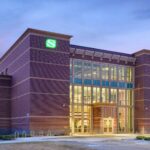The Role of Food and Beverage in the Workplace: A Great Reason to Gather
Think about something that is a constant in your everyday life — something your day revolves around. Could one of those things be food? Breakfast, lunch, dinner, snacks. And for many people, caffeinated beverages. With companies looking for creative employee benefits to bring people back to the office, one of those perks is the ready availability of healthy, affordable (and sometimes free!) food and beverages. From coffee bars and breakrooms to full-service cafés with chefs, many companies are choosing to provide food and beverage services in their workplaces to make life a little easier and more pleasant for their employees.
What are the options and what should you consider when including this type of amenity in your workplace? Our team has been designing innovative workplace environments for 30-plus years, and one of the key features increasingly requested are places for employees to eat and to gather together. Over the course of developing many different options for varying needs and employee populations, we’ve become well versed in the nuances of ensuring these spaces are a great fit for the company, its culture, and most importantly, its people.
Note: For the purpose of this article, I use the term “café” to refer to a place where employees can order hot or cold meals and drinks, and the term “elevated breakroom” to refer to a self-service, yet enhanced, employee breakroom with food storage and meal prep functionality.
The Benefits of a Workplace Café or Elevated Breakroom
Employees want amenities and perks that demonstrate they are seen, valued, and appreciated… in the office.
Cushman & Wakefield — Amenities that Matter: What Brings Employees Back to the Office
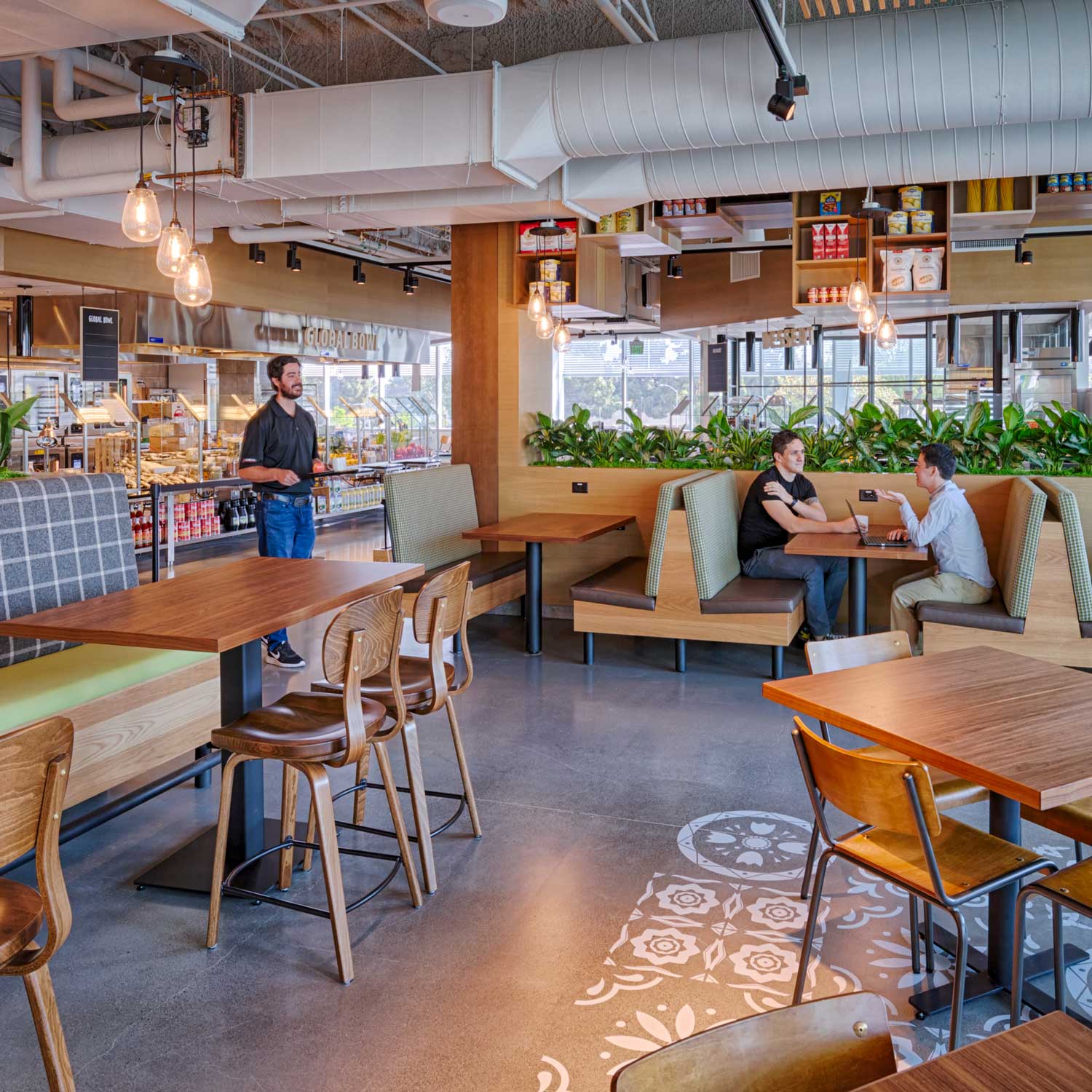
Workdays are busy — often nonstop with meetings and deadlines and prep for yet more meetings. Finding time to run out for lunch can be tough, and let’s face it, not all of us are good about packing a lunch in the morning. But when a full-service café is right around the corner from your desk, or down the hallway with a place to sit and collaborate with colleagues, finding time to recharge the brain and body can be so much easier. With a focus on employee health and wellness in the workplace, which has become prevalent in mainstream conversation since the pandemic, the benefits of helping employees conveniently grab a healthy meal are many.
Health and Wellness. No one likes the “hangries.” Food helps people stay motivated, happy, creative, and focused. Providing meal options that are varied, healthy, and delicious is one way employers can show they care about the well-being of their employees. Projects that adhere to the WELL Building Standard v2 align with a Nourishment concept that encourages the creation of food environments where the healthiest choice is the easiest choice. Eating fresh fruits and vegetables and staying away from highly processed foods, for example, can improve attention, memory, and our ability to function.
Collaboration and Social Bonding. Team lunches, meet-ups with colleagues and clients, and even the ability to have friends and family share a meal with you during the weekday can be highly rewarding activities that inspire people to come into the office. The collaboration and comradery that happen in person can occur at an even deeper level when you come together in a more casual setting beyond your desks, such as an in-house café.
Convenience and Choice. We’re all trying to maximize our days while taking care of ourselves (and everyone else in our lives). Knowing we don’t have to spend extra time and thought on what to eat can make the workday easier. Grab and go options provide a way to take lunch outside, to a meeting, or just get back to your desk quicker to finish up that deadline. Giving people agency and choice to do their own thing — think coffee machines, refrigerators, microwaves, and comfortable places to sit — also make the office more welcoming and signals that it, too, is a space for living.
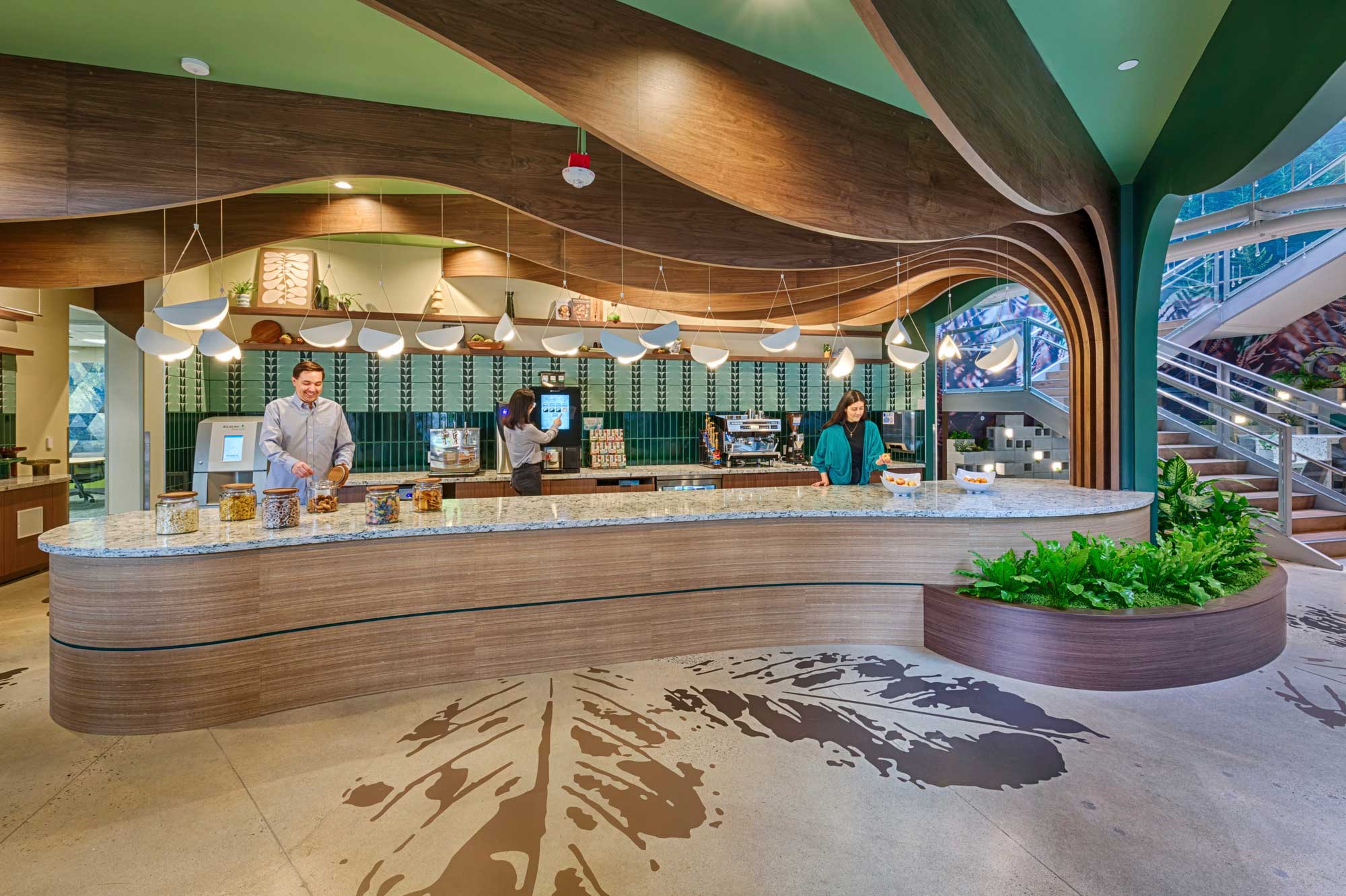
Food for Thought: Key Considerations
Relaxation spaces, healthy food services, and outdoor areas top the list of amenities that can lure workers into their city offices as they seek a feeling of connectedness with colleagues along with environments that are as comfortable as home.
Regenerative Workplace report from JLL
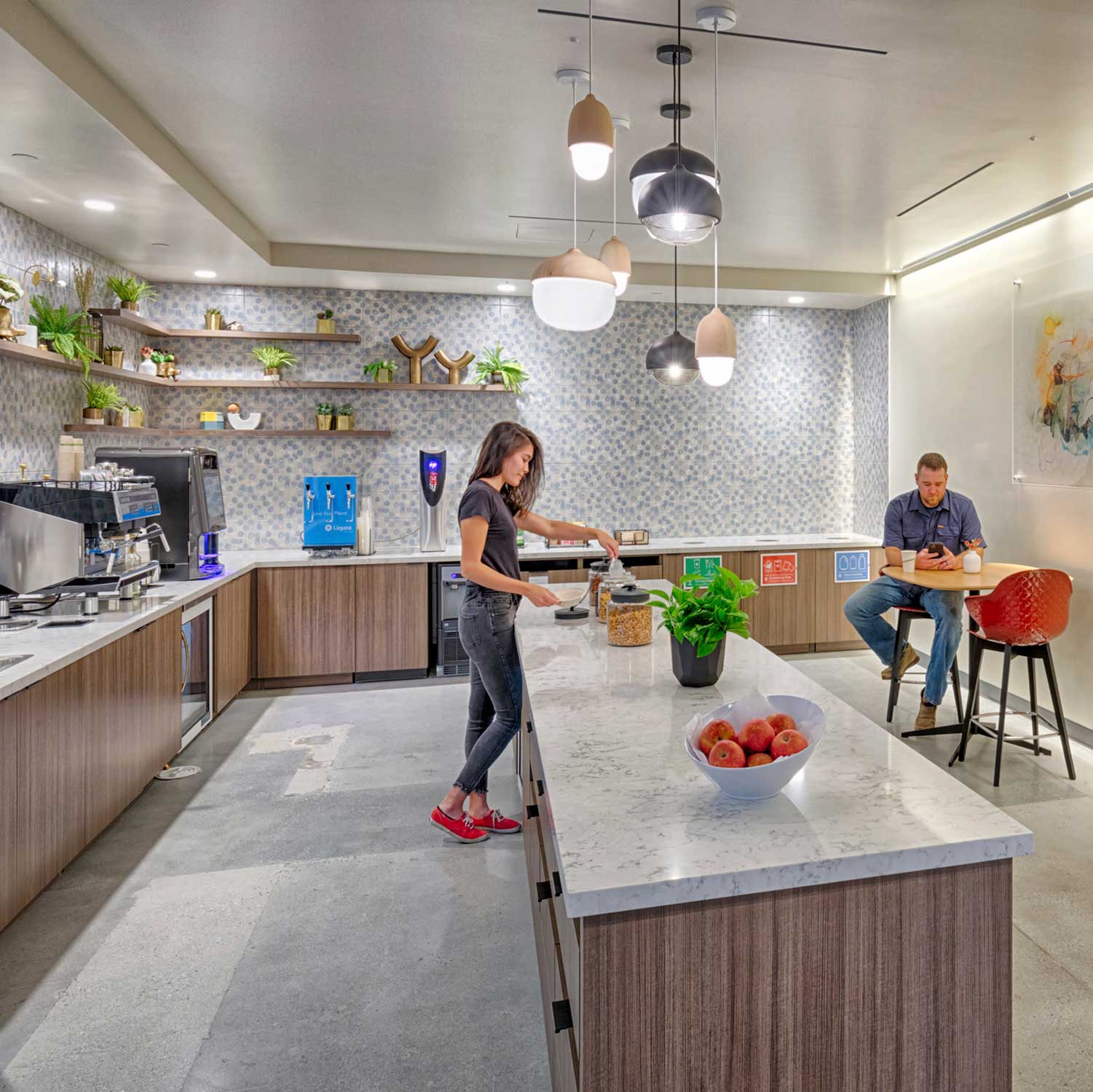
The type of food and beverage space you’ll need largely depends on factors such as the type of building you’re in (or that you plan to develop or occupy), where it’s located, the number of employees you have, the type of food you’d like to have available, and if you’d like the space to be multi-functional.
Building Type
The square footage you have available in your building will be a key factor in determining what type of food and beverage space to incorporate. For some of our larger clients with campus-style facilities, there’s often room for a full-service café, as well as what we think of as elevated breakrooms on each floor of a building. But for other clients who may be in a smaller building or occupy a single floor of a larger building, self-service breakrooms are a great option.
Full-service cafés in workplaces can offer a variety of hot and cold menu options and be open for breakfast, lunch, and special events. These are typically a good choice for companies with over 50,000 sq. ft. of total office space, more than 200 employees at a location, employees with long commutes, and those with few food and beverage options in the area.
With full-service cafés, design considerations include both front-of-house and back-of-house functionality and equipment. Front-of-house design focuses on the flow of people through the space, seating and seating arrangements, serving areas, lighting, and all the interior design factors that create a welcoming, comfortable space. Back-of-house design not only focuses on the users and flow of people within the space, but also the placement of large appliances and equipment, HVAC and electrical systems, fire protection, hood requirements, cleanability, durability, and more.
Elevated breakrooms on the other hand are great for offices with a smaller footprint and smaller employee population of about 100 employees or less. These types of breakrooms usually include a sink or two, dishwasher, microwave and toaster ovens, coffee machines, and at least one refrigerator. Other features that have become popular in recent years are tea bars, espresso machines, and kegerators for things such as on-tap kombucha or seltzer waters. To level up the standard breakroom, employers can provide stocked beverage refrigerators and pre-made breakfast and lunch options, such as yogurt and granola, fruit, sandwiches, salads, and snacks that employees can purchase or that are provided for free as part of an employee benefit.
Today’s breakrooms have much of the same functionality as a home kitchen and can be just as inviting as a central hub for gathering. There are many different ways to design this type of space, incorporating aesthetics that align with a company’s culture and brand, but they all tend to include a combination of microwave and toaster ovens, coffee and espresso machines, refrigerators, dishwashers, sinks, and seating areas. These breakrooms also can be stocked by the employer with beverages, snacks, and healthy grab-and-go meals.
Location
When employees have to commute long distances and when the workplace is not centrally located among other businesses, such as affordable restaurants, it can be imperative for an employer to provide food and beverage options on site. And, at the least, ensure employees can easily prepare and heat food they bring from home.
To determine where a café or elevated breakroom should be located within a building, our team leverages tools such as vibe mapping to understand the flow of people within a space and to identify quite vs. busy zones. A full-service café, for example, should be centrally located and easily accessible to all employees, preferably with plenty of daylight and access to the outdoors — or enhanced with biophilic design and/or products that mimic daylight.
Number of Employees
The number of employees you have coming into the office will certainly impact your decision when it comes to how much you’ll want to invest in a food and beverage space, but keep in mind that this type of benefit might encourage more people to come back to the office. Investing in a full-service café with staff is a big expense but can be well worth it when you have enough people utilizing this amenity and if you’re focused on recruiting and retaining top talent in competitive industries.
What’s on the Menu
One of the most important considerations of designing a food and beverage space into your workplace is what you’ll have on the menu. This will dictate your appliance needs, hood requirements, and the type of mechanical and ventilations systems you’ll need to incorporate. Additionally, key decisions must be made about how many people will be using the space and whether it will be full-service or self-service.
Multi-Use Spaces
Often when designing a café or elevated breakroom in a workplace, we’ll help our clients meet other needs within the space. For example, if we incorporate seating areas with flexible furniture, a café can be used for a variety of purposes such as lunch-n-learns, presentations, heads-down work, client meetings, after-hours events, employee get-togethers, and so much more. Audio/video considerations, such as line of site to a monitor/screen and audio input and speakers are also important to consider to ensure a well-designed, fully functional multi-use space. In our design work, we carefully consider space planning and adjacencies, circulation, seating types, and access to power and technology to make the most of each space and meet the needs of our clients and their employees.
Design Expertise Needed for a Successful Project
Our user-focused, multidisciplinary design practice takes a holistic view of each project — from conception to completion and beyond in the form of post occupancy evaluations and research.
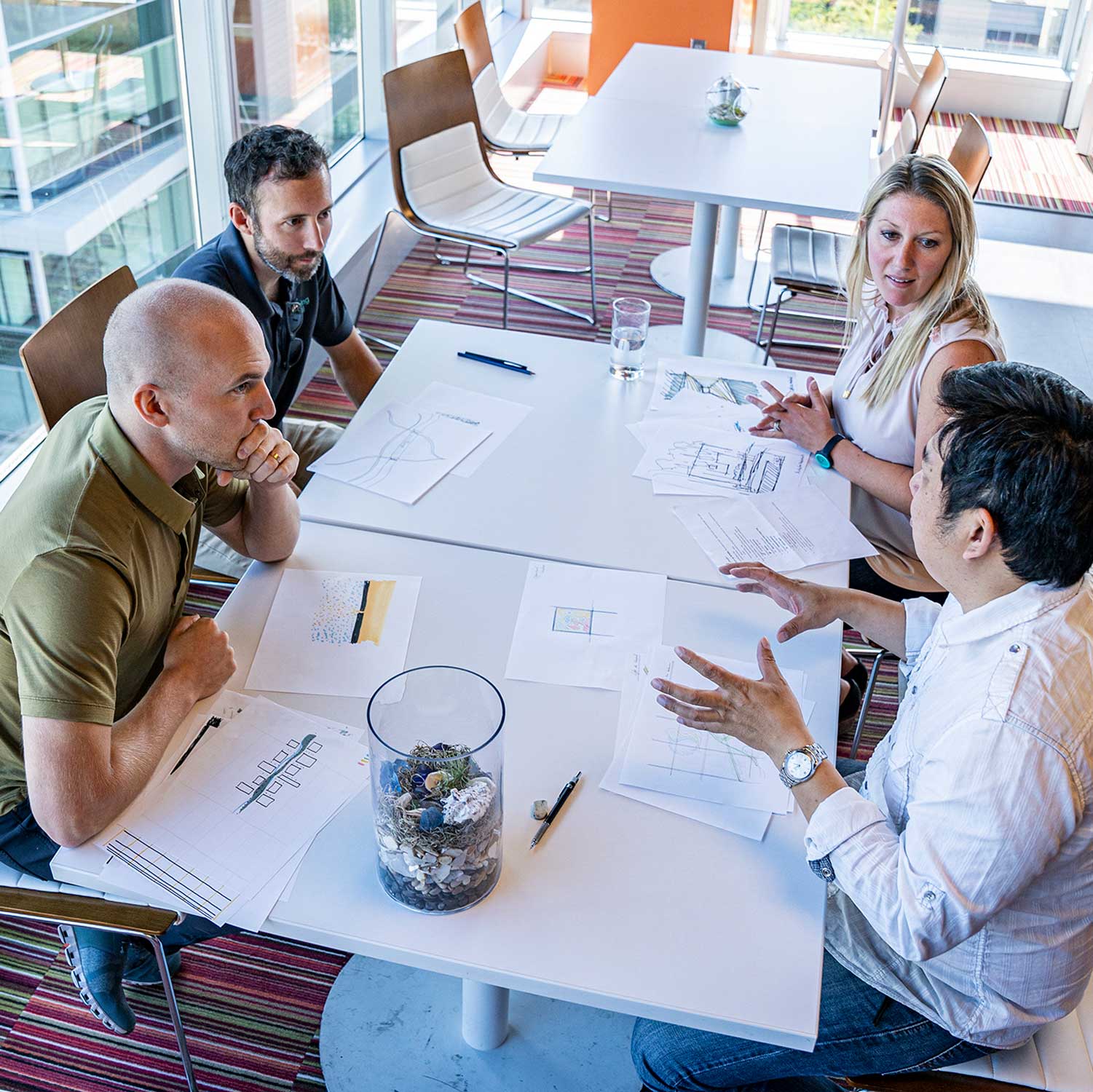
When it comes to designing workplaces, we strive for a thorough understanding of each client’s culture and values. Getting to know you and your employees is part of our holistic approach to each project. Our work often begins with research, helping our clients fully understand what their employees desire when it comes to perks and amenities. Once this is understood, we utilize the talents of our multidisciplinary team — ranging from architecture, interior design, and lighting design to electrical, mechanical, and structural engineering — as well as our partnerships with specialty kitchen consultants to ensure a successful project.
If you’re considering bringing an amenity space like a café or elevated breakroom to your workplace, we’d love to help! Our experience and love of envisioning great places to work, combined with having all design disciplines in-house, make us a great partner in helping you support the well-being of your employees.


